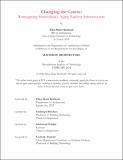| dc.contributor.advisor | Reinhart, Christoph | |
| dc.contributor.advisor | Nahleh, Mohamad | |
| dc.contributor.author | Reinhard, Ellen Marie | |
| dc.date.accessioned | 2024-03-21T19:08:57Z | |
| dc.date.available | 2024-03-21T19:08:57Z | |
| dc.date.issued | 2024-02 | |
| dc.date.submitted | 2024-02-22T22:02:29.671Z | |
| dc.identifier.uri | https://hdl.handle.net/1721.1/153833 | |
| dc.description.abstract | Countries worldwide have been experiencing a rise in the number of decommissioned nuclear power plants due to the infrastructure’s finite lifespan, ranging from 20 to 60 years. Consequently, nearly all of today’s global operating 410 nuclear power plants will soon reach their operating end of life, with an additional 263 already having ceased operations. Of those, only a few have attempted to repurpose them with programs aimed at reintegrating the isolated site into its existing context. This thesis proposes to change that course by reimagining alternative ways of adaptively reusing the remaining infrastructural buildings to facilitate the process of reconnection.
The thesis centers on Switzerland, home to some of the world’s oldest nuclear power plants. One of them, based in Mühleberg, is the only decommissioned nuclear power plant in Switzerland to date and is therefore a pioneer to this process. The lengthy 15-year and costly $3.2Bn USD process dedicated to the safe nuclear fuel removal and building demolition lasts until 2034. Following that, the remaining greenfield, currently surrounded by agricultural land, would be available for new purposes.
The proposal imagines transforming the nuclear power plant in Mühleberg into an accessible pumped hydro storage system for energy storage. In addition, indoor hydroponics and outdoor agricultural land serve as extensions for the longstanding agricultural community. Beyond economic uses, recreational spaces are dispersed throughout the site for larger community engagement and participation.
Zooming back out to the larger picture of aging nuclear energy infrastructure, this thesis uses the Mühleberg narrative on other affected sites globally. It also reflects on potential opportunities that arise when considering scalability. | |
| dc.publisher | Massachusetts Institute of Technology | |
| dc.rights | In Copyright - Educational Use Permitted | |
| dc.rights | Copyright retained by author(s) | |
| dc.rights.uri | https://rightsstatements.org/page/InC-EDU/1.0/ | |
| dc.title | Changing the Course: Reimagining Switzerland’s Aging Nuclear Infrastructure | |
| dc.type | Thesis | |
| dc.description.degree | M.Arch. | |
| dc.contributor.department | Massachusetts Institute of Technology. Department of Architecture | |
| mit.thesis.degree | Master | |
| thesis.degree.name | Master of Architecture | |
